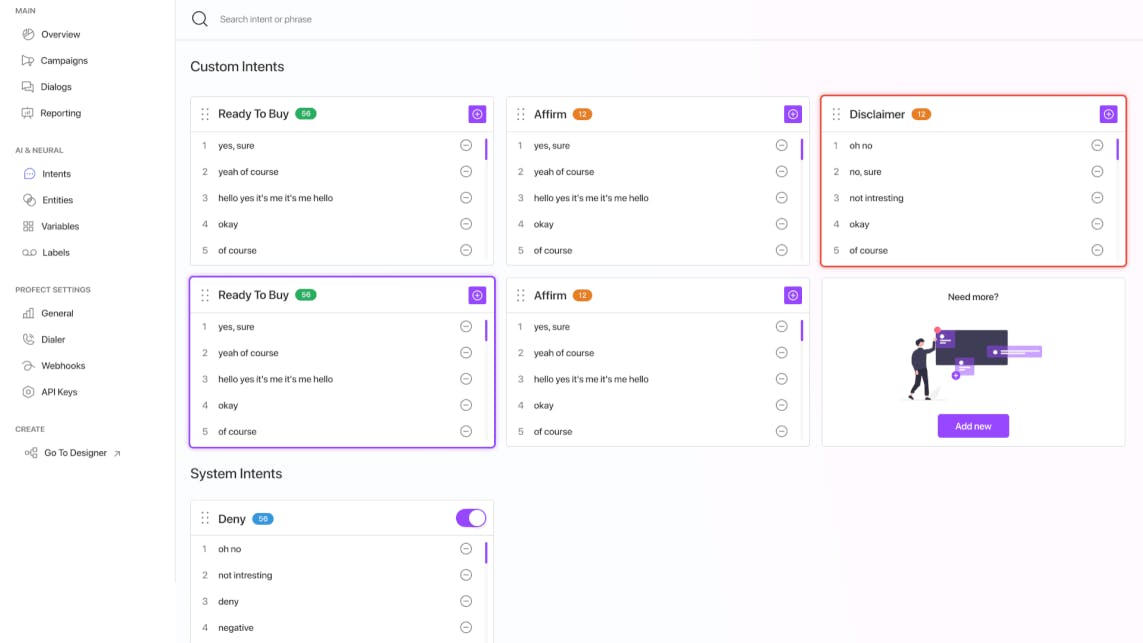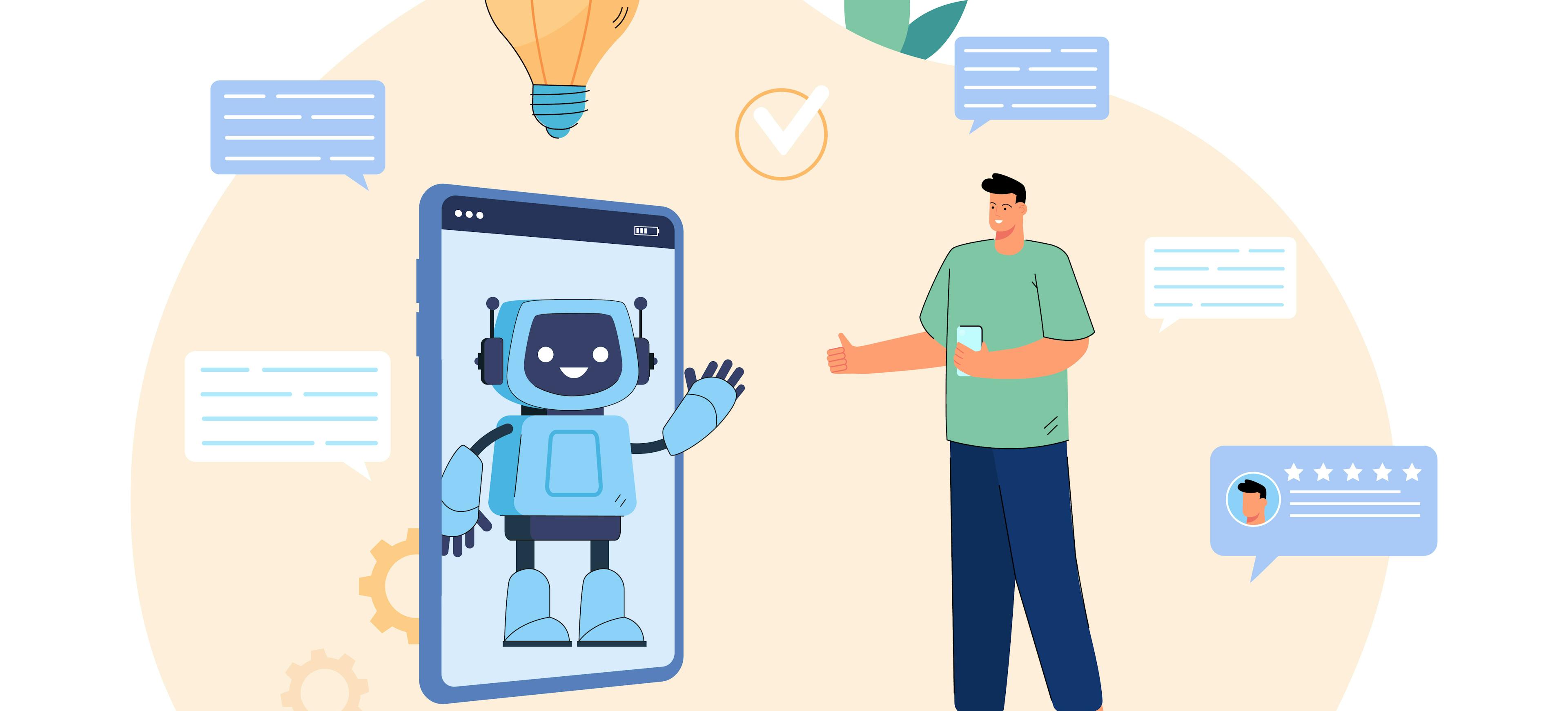Source: Freepik.com
According to Statista, an average live interaction with customer support lasted almost 12 minutes in 2022. The trends show that the number grows each year as customer expectations increase.
Can you imagine how much time and money you'd save if only you could automate at least a fraction of those interactions? The good news is that customer service conversations can easily be automated, and there are more ways to automate customer service, depending on your needs.
In this article, we'll help you solve one of the most common business owner dilemmas – chatbot vs conversational AI and what the right solution for your business is. Keep reading to discover more.
What is a chatbot?
Source: Freepik.com
Chatbot is a computer program able to answer questions and perform simple tasks like booking appointments. There are two main types:
- Rule-based chatbots are based on menus and pre-defined scripts (if the customer presses this button, say this), making them suitable only for simple, basic tasks.
AI chatbots can handle more complex conversations because they learn from customer interactions, which enables them to provide more accurate custom-made answers.
Chatbots: Quick facts
- Gartner predicts chatbots becoming the primary customer service channel by 2027.
- According to a recent survey, almost 70% of customers said the best aspect of using a chatbot was getting an immediate response. On the other hand, the same study revealed that 60% of customers claimed that the chatbot couldn’t solve their issues and they needed to talk to a real person.
Only one-quarter of customers in the US are happy to interact with a chatbot.
What is conversational AI?
Source: Freepik.com
Conversational AI is based on speech recognition, natural language processing and machine learning. This combination enables it to understand human language and have human-like conversations, providing more accurate responses and solving more complex tasks than traditional chatbots.
You can think of conversational AI as having a human-like virtual agent available 24/7. With its help, you can automate a huge part of customer experience: not only answering repetitive queries but also providing personalized assistance, recommendations, sending reminders and managing financial operations.
Click here to learn more about conversational AI examples and use cases across different industries.
Conversational AI: Quick facts
- Today, 123.5 million US adults use voice assistants at least once a month, which will continue to grow year after year.
- Most companies use conversational AI to provide customer support. Of all organizations using AI, 77% apply it for customer support, among other tasks.
According to Deloitte, companies that use conversational AI for customer interactions can expect anywhere from 15% to 70% of customer support cost reduction, depending on the channel.
Chatbot vs conversational AI: How they compare
Here are the main differences between chatbots and conversational AI.
Interaction
Chatbot solutions are based on set protocols and menus where you have to choose one of the pre-defined options by pressing a button, which makes interactions a bit limited and one-sided.
Conversational AI, on the other hand, can mimic human interactions and have a two-sided conversation.
While most chatbots can answer only one question at a time, conversational AI remembers historical data and can keep up with a more complex conversation flow, just like human agents.
Of course, there's always the option for a customer to ask to be transferred to a human agent if they think it's necessary.
There are two approaches to using conversational AI applications: you could use them to substitute your agents or to help them out by outsourcing the repetitive and time-consuming part of their work and allowing them to focus on tasks that matter more.
Input understanding
Basic chatbots have a very limited language understanding based on keywords and language identifiers, which means they can't understand natural language – they're just providing pre-defined output based on keywords they recognize.
Conversational AI is based on natural language processing (NLP) that enables it to understand nuances and do sentiment and intent analysis.
Conversational AI can recognize a customer's tone of voice and customize its response accordingly. For example, if it senses that a person is upset and nervous, it'll respond with empathy and support instead of just providing information like a robot.
Answers
While chatbots are based on scripts and can provide only pre-defined answers to a limited amount of questions, conversational AI voice agents can provide more personalized responses.
For example, suppose you're not satisfied with the answer you've got. In that case, you can provide additional information about your problem and guide conversational AI assistants to give you a more accurate response based on your input.
Complexity
Chatbots are good for answering simple customer queries, like answering frequently asked questions or providing basic instructions on doing something. They can also do simple tasks like booking appointments and reservations, sending reminders or asking for feedback.
Conversational AI can handle more complex user queries, like asking for professional assistance or help with a particular situation not covered in the script. It can understand the context and nuances, adapt to them and sustain an open-ended conversation with a customer.
Chatbots vs conversational AI: Comparison table
|
Chatbots |
Conversational AI |
|
|
Understanding |
Respond only to exact keywords and language identifiers |
Has a natural language understanding |
|
Interaction |
Provide only pre-defined answers based on a script |
Can have human-like conversations and answer open-ended questions |
|
Complexity |
Help only with simple queries and tasks |
Can answer more complicated questions and perform complex tasks |
|
Personalization |
Provide generic answers |
Provides personalized, custom-made answers |
|
Autonomy |
Can be used only to automate routine tasks, can't replace human agents in most cases |
Can replace human agents in many situations due to being able to mimic human conversations |
Chatbots vs conversational AI: Which is the right one for you?
Source: Freepik.com
It's time to make a final decision. Here are a few factors to consider when choosing between chatbots and conversational AI:
- Your needs: Chatbots could be enough if you only need to automate repetitive tasks. If you want a solution that can replace real agents without lowering service quality, choosing conversational AI is much better.
- Personalization: If your customers ask you mostly generic questions (working hours, payment options, etc.), a simple chatbot could be enough. If you want to provide personalized recommendations and help them solve their problems, you can do this only through conversational AI technology.
- Budget: More sophisticated conversational AI solutions often come with a higher price, but they can help you save a lot of money in the long run by lowering the need for human agents and providing an exceptional customer experience.
So, what does it really mean?
Here's a list of businesses that can benefit from using rule-based chatbots:
- Appointment-based services that can use chatbots for bookings and sending reminders
- Small local businesses that can use chatbots to automate inquiries about working hours and similar
- Customer service teams that can use chatbots to automate frequently asked questions so that they have more time to solve complex issues that require a human input
Here's a list of businesses that can benefit more from using conversational AI tools:
- E-commerce: AI in e-commerce can boost your revenue by providing personalized recommendations and improving customer satisfaction
- Healthcare: Voice recognition technology in the medical field is great at handling sensitive patient information, providing empathy and lowering the risk of human error
- Finance and banking: Conversational AI in banking enables clients to do complex finance operations on their own, with the help of its guidance
Call center automation: If you want to reduce costs by fully automating customer interactions, the only way to do so is by using conversational AI voice assistants
Start your conversational AI journey withvTalk.ai

If you're ready to experience all the benefits of conversational AI but don't know where to start, we've got you covered.
vTalk.ai enables you to create your own conversational AI platform within minutes without any coding. Our solution is fully customizable, and you can train it according to your needs, no matter your industry.
Our AI virtual assistants can fully automate customer experience and even replace human agents if that's what you want. You can use them both for inbound and outbound calls.
Other benefits include:
- They're not only able to answer all kinds of customer questions, but they're capable of sustaining two-sided conversations thanks to natural language understanding.
- They're able to determine the gender of the client based on advanced voice recognition and automatically adjust the script.
- They can also send SMS and emails after the conversation or at the user’s request, eliminating the need to have chatbots for this purpose.
- You can train our conversational AI assistants to make appointments based on free slots in your calendar and perform similar tasks.
- Finally, our solution comes with advanced analytics. You can listen to all conversations, transcribe them into text, translate them into other languages etc. It enables you to automatically analyze a large volume of past conversations, discover patterns and insights that will help you improve customer satisfaction.
Conclusion
You should have a better understanding of conversational AI and chatbots by now. Both of them have many benefits, but you can use conversational AI for a broader range of purposes and it's better at understanding user intent and mimicking two-way human conversation.
The best part is that you don't have to be a conversational AI expert to create your own AI assistant. v.Talk.ai enables you to set up your own customizable conversational AI platform within minutes, with no coding required.
Request a demo and get started today.
FAQs
What is the difference between conversational AI and chatbot?
Chatbots are usually based on menus or decision trees, meaning they can provide you only with pre-defined answers, answering only basic queries or a limited number of questions.
Conversational AI is more advanced – it's trained to create human-like interactions and two-sided conversations instead of providing pre-written responses. It can also answer open-ended questions and provide personalized recommendations and suggestions.
What are the 4 types of chatbots?
There are different classifications, but the following are the most popular types of chatbots:
- Rule-based chatbots (also called menu-based chatbots)
- Keyword recognition-based chatbots
- Machine learning chatbots
- AI chatbots
Are chatbots and AI the same?
No. Traditional chatbots were built before artificial intelligence became widespread and are mostly based on machine learning. While some modern chatbots use AI to provide more accurate responses (there are also conversational AI chatbots today), most chatbots are simpler and not based on artificial intelligence.
Is conversational AI a part of NLP?
Conversational AI uses NLP to understand human language and provide more accurate responses. It'd be more accurate to say that NLP is one aspect of conversational AI, along with other components that make it so powerful.
